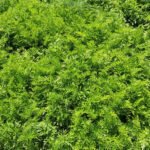Are you looking for a natural and sustainable way to create pathways around your vegetable garden? Using pine needles as a pathway material may be the solution you’ve been searching for.
Not only do pine needles add a rustic and charming touch to your garden, but they also offer numerous benefits for your plants and soil. In this article, we will explore the many advantages of using pine needles for paths, how to choose the right type of pine needles, preparing the area for the pathway, designing and laying out the pathway, maintaining it, and additional creative uses for pine needles in your vegetable garden.
Pine needle pathways are not only visually appealing but also provide several benefits for your vegetable garden. As we delve into this topic further, we will discover how using pine needles can help improve soil health by adding organic matter as they break down over time.
Additionally, they act as a natural mulch, helping to retain moisture in the soil and regulate temperature fluctuations. The acidity of pine needles also creates an environment that deters weed growth while benefiting acid-loving plants like blueberries and strawberries.
When it comes to creating a beautiful and functional pathway using pine needles, selecting the right type of pine needles is crucial. There are various species of pine trees with different needle lengths, colors, and textures to consider.
Understanding how to choose between them will ensure that you achieve the desired aesthetic appeal while maximizing their impact on soil health. We will also cover how to prepare the area for laying out the pine needle pathway so that it remains low-maintenance and long-lasting.
Benefits of Using Pine Needles for Pathways
Pine needles are a natural and sustainable option for creating pathways around vegetable gardens. There are various benefits to using pine needles for pathways, making them a popular choice among gardeners. Here are some of the key advantages of using pine needles for your garden paths:
- Organic Mulch: Pine needles act as a natural mulch as they break down over time, adding valuable organic matter to the soil.
- Weed Control: The dense layer of pine needles helps suppress weed growth, reducing the need for frequent weeding along the pathway.
- Moisture Retention: Pine needles help retain moisture in the soil, reducing the need for frequent watering, especially during hot summer months.
In addition to these benefits, pine needles also add an attractive and rustic look to the garden, enhancing its aesthetic appeal. They are also readily available in many areas, making them a cost-effective option for creating pathways.
When choosing the right type of pine needles for your garden pathways, it’s important to consider factors such as needle length and texture. Longleaf pine needles, known for their durability and attractive appearance, are a popular choice for garden pathways. On the other hand, short needle varieties may break down more quickly but can still serve as an effective mulch material.
Overall, using pine needles for paths around vegetable gardens not only provides practical benefits but also adds a natural and rustic charm to the garden space. By embracing this sustainable option, gardeners can create beautiful pathways while contributing to the health and sustainability of their vegetable gardens.
Choosing the Right Type of Pine Needles
When choosing the right type of pine needles for creating pathways around vegetable gardens, it is important to consider the specific characteristics of the different pine tree species. Some common types of pine trees that are used for their needles include longleaf pine, slash pine, loblolly pine, and shortleaf pine. Each type of pine needle has its own unique qualities that make it suitable for different purposes in gardening.
Longleaf pine needles are known for their long length and flexibility, making them an excellent choice for creating soft and springy pathways. On the other hand, slash pine needles are shorter and stiffer, which can provide a more compact and sturdy base for pathways. Loblolly pine needles have a medium length and thickness, offering a balance between softness and durability. Shortleaf pine needles are fine and soft, making them ideal for use as mulch in vegetable gardens.
It’s also important to consider the availability of each type of pine needle in your area. Some species may be more abundant or easier to collect than others.
Additionally, the color of the needles can vary from dark green to light brown, so you’ll want to choose a shade that complements your garden landscape. Overall, selecting the right type of pine needles is essential for ensuring that your pathway not only looks beautiful but also serves its intended purpose effectively.
| Type of Pine Needles | Main Characteristics |
|---|---|
| Longleaf Pine Needles | Long length and flexibility |
| Slash Pine Needles | Shorter and stiffer; provide a compact base |
| Loblolly Pine Needles | Medium length and thickness; balance between softness and durability |
| Shortleaf Pine Needles | Fine and soft; ideal for use as mulch |
Preparing the Area for the Pine Needle Pathway
When preparing the area for a pine needle pathway around vegetable gardens, it is important to start with a clean and clear space. Begin by removing any existing vegetation, rocks, or debris from the area where you plan to lay out the pathway. This will ensure that the pathway is even and free of obstructions. It is also recommended to dig a shallow trench along the intended path to create a defined border for the pine needles.
Once the area is cleared and prepared, consider adding a layer of landscaping fabric or weed barrier underneath the pine needles. This will help prevent weeds from growing through the pathway while still allowing water to penetrate through to the soil below. Additionally, adding a thin layer of gravel underneath the fabric can improve drainage and stability for the pathway.
Finally, take into account any slopes or drainage patterns in the garden area when preparing for the pine needle pathway. It may be necessary to make adjustments or install small barriers to prevent erosion and maintain the integrity of the path over time. By taking these steps to prepare the area for a pine needle pathway, you can ensure that it remains durable, low-maintenance, and visually appealing for your vegetable garden.
| Preparing Steps | Description |
|---|---|
| Clearing | Remove existing vegetation, rocks, and debris from intended path. |
| Adding Barrier | Add landscaping fabric or weed barrier under pine needles to prevent weed growth. |
| Consider Drainage | Take into account any slopes or drainage patterns in garden area. |
Designing and Laying Out the Pathway
Creating a Functional Layout
When it comes to designing a pine needle pathway around vegetable gardens, it is essential to create a functional layout that not only complements the garden but also allows for easy accessibility. Begin by deciding on the width of the pathway, considering factors such as the size of your vegetable garden and how many people will be using the path at once.
It’s important to ensure that the pathway is wide enough for comfortable walking without being too intrusive on the garden space.
Adding Personal Touches
In addition to functionality, designing a pine needle pathway also presents an opportunity to add personal touches to your vegetable garden. Consider incorporating curves or gentle turns in the pathway to create visual interest and break up the straight lines typically found in most gardens. You can also use different colors or types of pine needles, such as longleaf or loblolly pine needles, to create patterns or borders along the path, adding decorative flair to the garden.
Laying Out the Pine Needle Pathway
Once you have finalized your design for the pine needle pathway, it’s time to lay out the path around your vegetable garden. Start by laying down a layer of landscape fabric or cardboard along the intended route of your pathway to help suppress weeds and prevent erosion.
Then, begin spreading a thick layer of pine needles over the fabric or cardboard, ensuring that they are evenly distributed and packed down to create a stable walking surface. Be mindful of any slopes or uneven areas in your garden, as these may require additional adjustments when laying out the path using pine needles.
By carefully designing and laying out a pine needle pathway around your vegetable garden, you can create an aesthetically pleasing and functional feature that enhances both the beauty and sustainability of your garden space. Whether you choose straight lines or curved pathways, incorporating personal touches into your design can elevate this simple yet effective landscaping technique into an integral part of your overall gardening experience.
Maintaining the Pine Needle Path
Once you have designed and laid out your pine needle pathway, it is essential to maintain its beauty and functionality. Proper maintenance will ensure that your pathway remains an attractive and sustainable addition to your vegetable garden.
Here are some tips for maintaining your pine needle path:
- Regular raking: Use a rake to gently fluff up the pine needles and remove any debris that may have accumulated on the path. This will help maintain an even and comfortable surface for walking.
- Weed control: Keep an eye out for any weeds or grass that may be encroaching on the edges of the pathway. Pull them out by hand or use a natural herbicide to keep the area around the path clear.
- Replenishing the pine needles: Over time, the pine needles may start to break down and decompose. To maintain the appearance and functionality of your pathway, add a fresh layer of pine needles every year. This will also help control weed growth and retain moisture in the soil.
- Inspect for erosion: Check for any signs of erosion or washout after heavy rainfall. If necessary, add extra pine needles or install edging to prevent further erosion.
By following these simple maintenance tasks, you can ensure that your pine needle pathway remains a beautiful and sustainable feature in your vegetable garden for years to come.
Overall, using pine needles for paths around vegetable gardens offers numerous benefits like natural weed control, moisture retention in soil, and aesthetic appeal. By properly maintaining the path with regular raking, weed control, replenishing of pine needles, and inspecting for erosion, you can continue to enjoy all these advantages while keeping your garden looking pristine.
Other Creative Uses for Pine Needles in the Vegetable Garden
Mulch for Garden Beds
Pine needles are not only great for creating pathways, but they also make excellent mulch for garden beds. The acidic nature of pine needles helps to acidify the soil, making them particularly beneficial for acid-loving plants like blueberries, azaleas, and rhododendrons. The needle structure of pine needles also allows them to interlock, creating a natural barrier that helps to suppress weeds and retain moisture in the soil.
Composting Material
Another creative use for pine needles in the vegetable garden is as composting material. Although pine needles break down more slowly than other types of organic matter, they can still be added to the compost bin or pile. To speed up the decomposition process, it’s best to mix pine needles with other compostable materials such as grass clippings, kitchen scraps, and leaves.
Natural Pest Repellent
Pine needles can also serve as a natural pest repellent in the vegetable garden. Certain pests like slugs and snails are repelled by the texture and scent of pine needles. By scattering a layer of pine needles around susceptible plants, you can help deter these unwanted visitors without resorting to chemical pesticides.
By utilizing pine needles in these various ways, you can not only create a visually appealing and sustainable pathway around your vegetable garden but also enhance the overall health and productivity of your garden beds.
Conclusion
In conclusion, using pine needles for pathways around vegetable gardens not only adds a beautiful and natural touch to the garden, but also offers several sustainability benefits. The use of pine needles as a pathway material is a cost-effective and environmentally friendly alternative to traditional hardscaping materials. By repurposing pine needles that would otherwise be considered yard waste, gardeners can create a visually appealing and functional pathway that ties in seamlessly with the natural surroundings of their vegetable gardens.
Furthermore, the benefits of using pine needles for pathways extend beyond their aesthetic appeal. Pine needles are naturally acidic and decay slowly, making them an excellent weed suppressant and moisture regulator. This means less time spent weeding and watering the paths, allowing gardeners to focus on tending to their vegetable beds instead. Additionally, as pine needles break down over time, they contribute organic matter to the soil, enriching it with essential nutrients for healthy plant growth.
As we continue to explore sustainable gardening practices, it’s clear that incorporating pine needle pathways into vegetable gardens offers both practical and environmental advantages. Whether used as a meandering path through the garden or strategically placed to provide access to raised beds or planting areas, the beauty and functionality of these pathways make them a valuable addition to any vegetable garden.
By embracing this natural and sustainable approach to garden design, gardeners can create a harmonious outdoor space that reflects their commitment to both beauty and sustainability.
Frequently Asked Questions
Is It OK to Put Pine Needles Around Tomato Plants?
It is generally okay to put pine needles around tomato plants. Pine needles can help in keeping the soil acidic, which is beneficial for tomatoes. However, it’s important to monitor the pH levels to ensure they don’t become too acidic.
What Vegetables Do Not Like Pine Needles?
Some vegetables that do not like pine needles include root crops like carrots and potatoes. Since pine needles are acidic, these vegetables prefer a more neutral pH level in the soil. Therefore, it’s best to avoid using pine needles as mulch for them.
What Disadvantages to Soil Is Using Pine Needles for Mulch?
Using pine needles for mulch can pose some disadvantages to the soil. One major disadvantage is that pine needles decompose slowly, which means they may not release nutrients into the soil as quickly as other types of mulch.
Additionally, they may also create a thick mat that inhibits water penetration and air circulation in the soil, leading to potential issues with plant growth.

If you’re looking to get into vegetable gardening, or are just looking for some tips on how to make your current garden better, then you’ve come to the right place! My name is Ethel and I have been gardening for years. In this blog, I’m going to share with you some of my best tips on how to create a successful vegetable garden.





